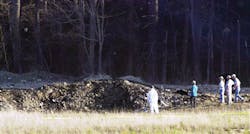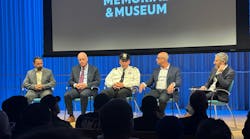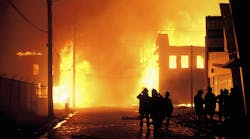But one did 10 years ago and changed Shanksville forever.
Terry Shaffer, chief of the Shanksville Volunteer Fire Department, says there's no amount of training and no amount of equipment that could possibly prepare firefighters for the kind of event that happened when America was attacked on Sept. 11, 2001 and Shanksville became the crash site of Flight 93. Terrorists intended to crash the plane in Washington, D.C. and to kill as many people there as possible, but passengers brought the plane down early to thwart that threat.
Ten years after the incident, Shaffer can recall details as if they were yesterday -- like the smell of burning jet fuel, billowing smoke, the debris field and the sense of hopelessness that there was nothing responders could do to reverse or help the situation.
At Firehouse Expo in Baltimore this summer, Shaffer spoke about the facts, like how the Boeing 757 aircraft was loaded with 21 tons of fuel, enough to travel coast to coast from Newark, N.J. to San Francisco, Calif. About how it hit a reclaimed coal mine in Stonycreek Township in a tiny community near Shanksville while traveling at 563 miles per hour, and how it essentially vaporized in a 15-foot deep, 30-foot round crater, killing all souls on board.
Shaffer, who has been chief of Shanksville for 25 years and a member for 34 years, was working at Pepsico, about 30 miles away when the crash happened.
It was 10:06 a.m.
"My wife called me and said I had better get home," Shaffer said. So, he left work wondering what had happened on such a beautiful late summer morning. Little did he know that he was about to spend the next two weeks on the site and become part of a six-week investigation of an event that would become forever woven into the nation's history.
Crews responding to the scene reported heavy black smoke visible for miles, and upon arriving, they realized there were no survivors. There would be no medical response.
Shaffer said he and his men spent the initial response to the crash putting out spot fires that had ignited in the woods around the crash site and securing the perimeter, knowing it was likely a crime scene. They wanted to keep people out to preserve evidence, but also to protect them.
"We had a hazmat scene with jet fuel and human remains and the bits and pieces of the plane scattered about," Shaffer said. "... The smell of jet fuel and human remains is not something you ever forget."
As more units responded, the local volunteers suddenly found themselves in the spotlight and the incident commanders of a scene that was far bigger than the community they normally protect. Almost by the hour, more and more people showed up to investigate and help with the site management.
At its height the scene had more than 1,500 people representing 74 local, state and federal agencies, Shaffer said.
A small city was built on the field and helicopters came and went with regularity, as did dignitaries. Shaffer was the host for most of these events.
It was the early hours of the event that were grueling, Shaffer said. Being out in the middle of a field in rural Pennsylvania was very isolating and most of the responders did not have a clear grasp of the bigger picture of what had happened on 9/11, Shaffer said.
"We had heard some things about a plane into the Pentagon and the planes that had crashed into the towers, but we didn't know much more than that," the chief said.
That's why everyone's nerves were rattled when a large commercial jet flew low over the site and circled later in the day on Sept. 11, 2001.
"We didn't know if we were under attack again or what it was," Shaffer said, recalling that he thought all aircraft had been grounded. "It scared the crap out of us."
It turns out to be federal authorities out of Chicago who were retracing the route Flight 93 had taken from Newark to the crash site. The jet later landed elsewhere in Pennsylvania and those officials drove to the site to continue their investigation.
Shaffer said he was pleased to be included in all of the command debriefings and planning sessions.
For obvious reasons, the FBI was the lead agency on the investigation, but agents never pushed local authorities aside, keeping them in the loop the whole time, Shaffer said.
Logistics became an important part of the operation as the scene shifted from an emergency to a recovery and investigation.
"We only worked during the daylight hours," Shaffer said, noting that most of the work was recovery of plane parts and human remains.
"Only eight percent of the remains were recovered," the chief said. "That's why the whole site remains the final resting place of those on Flight 93."
Shaffer said he was impressed with the efficiency with which the federal agents were able to get things done. A makeshift dirt road to the site was dusty and creating problems for those who were operating on the scene. So with lightening speed, the road was paved. Temporary cell phone towers were erected overnight and the Red Cross and Salvation Army were on hand to help feed all the people at the site.
"Local restaurants kept sending food to the site as well," Shaffer said.
Then, there were the outsiders who had to be monitored and controlled, the chief said, noting that the first on-site memorial occurred on Sept. 17 with family members being allowed to come to the site.
The press was kept two miles from the actual site and twice-daily press conferences seemed to satisfy most of the news corps, he said.
There were a few who tried to breech security lines and authorities had to confiscate one reporter's camera, Shaffer said.
Shaffer said there was also a challenge of firefighters and volunteers self-dispatching and trying to make it to the scene to provide assistance. While the gesture was well-intentioned, there wasn't much outsiders could do to help.
Those working the site were flagging fragments of the plane and using red flags to signify human remains, the chief said. Soil was then sifted and anything, and everything, recoverable from the site was collected and saved. Human remains were transported to the local National Guard Armory which was converted into a temporary morgue, Shaffer said.
After six weeks, the most intense parts of the investigation and recovery had been completed, but there hasn't been a day gone by that Shaffer hasn't had something to do with the crash of Flight 93, whether its memorials, family visits to the site, or planning for the national memorial that will open this weekend. It has defined the community and the fire department.
Shaffer said he made sure all of his firefighters participated in critical incident stress management sessions and, so far, he's been able to retain firefighters. Currently, he has about 45 members on the roster with about 22 who actively respond to all calls.
Once again, the spotlight will be on Shanksville this weekend as former President George W. Bush and Vice President Joe Biden are scheduled to be on hand for the opening of the national memorial at the site. And Shaffer knows the light will fade again, but Shanksville will never be completely out of the limelight.
"Every incident starts out as a local incident and it ends as a local incident," Shaffer said. And so it did for Shanksville and its involvement in the crash of Flight 93.






